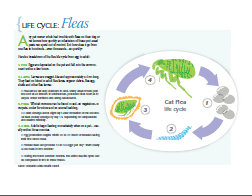Understanding the Flea Lifecycle:
Fleas thrive year round in our southern climate because the weather is warm and humid. Your pet can pick up fleas wherever an infestation exists, often in areas frequented by other cats and dogs, and also other animals, such as squirrels, rodents, raccoons and possums. Adult fleas are dark brown, no bigger than a sesame seed, and able to move rapidly over your pet’s skin.
Once the flea becomes an adult, it spends virtually all of its time on your pet. Female fleas begin laying eggs within 24 hours of selecting your pet as a host, producing up to 40 eggs each day. These eggs fall from your pet onto the floor or furniture, including your pet’s bed, or onto any other indoor or outdoor area where your pet happens to go. Tiny, worm-like larvae hatch from the eggs and burrow into carpets, under furniture, or into soil before spinning a cocoon. The cocooned flea pupae can be inactive for weeks before emerging as adults that are ready to infest your pet. The result is a flea life cycle of anywhere from 12 days to 6 months, depending on environmental factors such as temperature and humidity.
You may not know that your pet has fleas until their number increases to the point that your pet is obviously uncomfortable. Signs of flea problems range from mild redness to severe scratching that can lead to open sores and skin infections. One of the first things you may notice on a pet with fleas is “flea dirt” – the black flea droppings left on your pet’s coat. You may not actually see the fleas themselves, but they can still be on your pet and in the environment.
Fleas bite animals and suck their blood; young or small pets with heavy flea infestations may become anemic. Some pets can develop an allergy to flea saliva that may result in more severe irritation and scratching; these pets can become severely itchy from just one or two flea bites. Also, pets can become infected from certain types of tapeworms if they ingest fleas carrying tapeworm eggs (a pet may swallow a flea when using it’s teeth to scratch the flea bites or by licking itchy skin).
To view an illustration of the Flea Life Cycle, click on the image below:

Our Veterinarians Recommend:
Our Veterinarians recommend the use of an adult flea preventative immediately if you are finding fleas on your pet. We recommend NEXGARD or ADVANTAGE for dogs and REVOLUTION or ADVANTAGE for cats, which are monthly flea preventatives. We also recommend the one pill combination of Heartworm and Flea preventative contained in the one monthly tablet of TRIFEXIS.
To protect your pet and your environment from flea infestations we recommend that in addition to your monthly adult flea preventative, you also use a product that contains Lufenuron, which will inhibit flea eggs from hatching. For dogs, Lufenuron is included in the product SENTINEL, which is a monthly heartworm preventative and dewormer. For cats, Lufenuron is available in a product called PROGRAM, which is an injection that lasts for six months.
Always read and use each product as directed by the manufacturer. Most of these products limit the use of the medication on puppies and kittens until they reach a specific age and/or weight. Proper dosing is important – always use the proper dose size as directed for the weight of your specific pet.
Because much of the flea’s life cycle is spent off of your pet, treating only your pet will not eliminate the problem. If you only kill the adult fleas and do not prevent the eggs, larvae and pupae from developing, your pet will become re-infested when these fleas become adults and the cycle starts all over again. Therefore, in addition to treating your pet with the recommended medications, reduce the flea population in your house by thoroughly cleaning your pet’s sleeping quarters and vacuuming floors and furniture that your pet comes in contact with frequently. Vacuum on, around, and under any furniture that your pet comes in contact with. This will pick up any eggs and larvae in the environment, and also the vibration from the vacuum may stimulate the fleas in the pupae to hatch and you can vacuum them up as well.
Our Doctors do not recommend over-the-counter sprays, dips or foggers, as they have not found them to be effective in eliminating the main cause of flea infestations, which are eggs, pupae and larvae. While you can’t kill all of the fleas that your pet is going to encounter when it goes outside, you can keep the population down in the area around your house by using BENEFICAL NEMATODES, which are microscopic worms, that will eat flea larvae in the soil around your yard. We have found that the most effective Beneficial Nematode for flea control in our area is Steinernema Carpocapsae . For more information on Beneficial Nematodes, click this link: ARBICO ORGANICS. For information on how to purchase the Steinernema Carpocapsae Nematode, click this link ARBICO ORGANICS – NEMATTACK Beneficial Nematodes – SC , or copy and paste the following into your web browser and search for other providers: Beneficial Nematode Steinernema Carpocapsae.
Please give your veterinarian a call if you have any questions regarding the products or information mentioned above.




